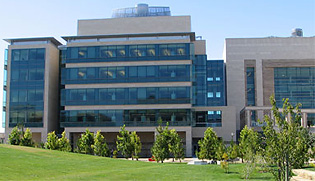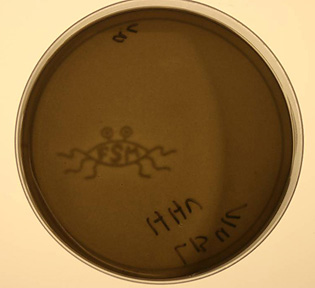
Wendell Lim, Christopher Voigt and Tanja Kortemme
Last week's announcement of a new NSF-funded university collaboration in synthetic biology, teaming scientists at UC Berkeley, UCSF, MIT, Harvard and Prairie View A&M University in Texas, is expected to further accelerate this ambitious new field. Synthetic biology is the design and construction of new biological entities such as enzymes, genetic circuits and cells, or the redesign of existing biological systems. It is a major focus of research at the
California Institute for Quantitative Biomedical Research, QB3, headquartered at the UCSF Mission Bay campus. The field builds upon advances in molecular, cell and systems biology and seeks to transform biology in the same way that synthesis transformed chemistry and that integrated circuit design transformed computing.

Byers Hall, QB3's UC San Francisco facility at the UCSF Mission Bay campus.
Funded by a five-year, $16 million dollar grant from the National Science Foundation (NSF), the
Synthetic Biology Engineering Research Center, or SynBERC, is gathering pioneers in the field of synthetic biology from around the United States into a unique "engineering" center. The center's researchers hope to ignite the field of synthetic biology in the same way that the developers of standardized integrated circuits in the 1960s ignited the field of semiconductor electronics. Matching funds from industry and the participating universities bring the total five-year commitment to $20 million, with the NSF offering the possibility of a five-year extension of the grant. Headquarters for the new five-university collaboration are at UC Berkeley. The director of the new center is Jay Keasling, PhD, professor of chemical engineering at UC Berkeley; deputy director is Wendell Lim, PhD, professor of cellular and molecular pharmacology and of biochemistry and physics at UCSF.
The element that distinguishes synthetic biology from traditional molecular and cellular biology is the focus on the design and construction of core components that can be modeled, understood and tuned to meet specific performance criteria, and the assembly of these smaller parts and devices into larger integrated systems that solve specific problems.
Synthetic biology advances at UCSF in the past three years include a $7 million National Institutes of Health (NIH) grant to support a pioneering QB3-led synthetic biology and nanomedicine research collaboration. The project, teaming UCSF, UC Berkeley and Lawrence Berkeley Laboratory scientists, is directed by UCSF's Lim.
The NIH program announced last year aims to apply engineering approaches to understand the design principles of cellular control systems, focusing particularly on those systems that control cell movement. The long-range goal is to be able to precisely engineer therapeutically useful cells.
Links:

This image represents the structure of two successive kinases in a cellular circuit that are organized by a scaffolding protein.
Early this year, UCSF's Lim reported in the journal Science his lab's progress in understanding the circuitry that directs cell fate:
Lim's lab reported a pioneering effort in synthetic biology in Science in 2003:
Links:
This spring, Lim, Chris Voigt, PhD, UCSF assistant professor of pharmaceutical chemistry, and Dyche Mullins, PhD, associate professor of cellular and molecular pharmacology, joined nearly 300 other biologists and engineers May 20-22 at UC Berkeley to share the latest triumphs in synthetic biology and to discuss how to ensure that the field's tools are used to benefit society.
Links:

Living photograph: Scientists at UCSF and U. of Texas have been creating living photographs by genetically engineered microbes to become "biological film." Bacteria exposed to light produce dark pigment, while those in the dark do not. Photo/Aaron Chevalier (UT-Austin)
Voigt, also a member of the new NSF-funded initiative, organized a similar symposium at the UCSF Mission Bay campus last year. Among the ambitious synthetic biology research programs Voigt is leading is an effort to engineer a microbe capable of invading a tumor and destroying it. Last year, as proof of principle in another project, Voigt's lab engineered bacteria to create living photographs.
Links:
UCSF's newest member of the synthetic biology team, and also a member of the new NSF synthetic biology center is Tanja Kortemme, PhD, assistant professor of biopharmaceutical sciences. A computational biologist, Kortemme is keenly interested in how biological molecules communicate with each other, and how this communication encodes the processing of information.
Links:



